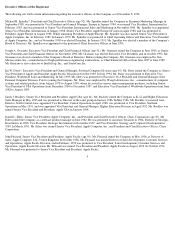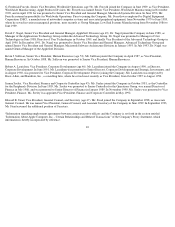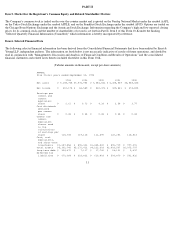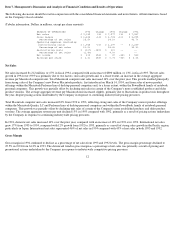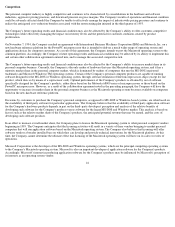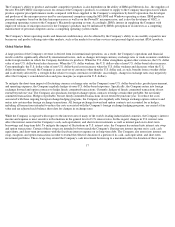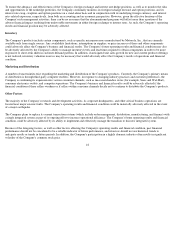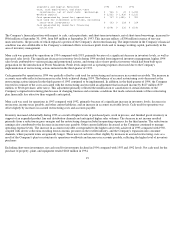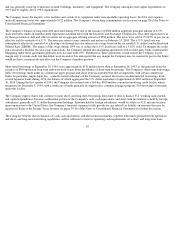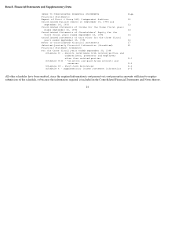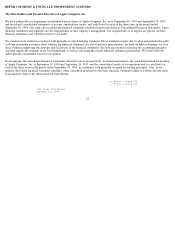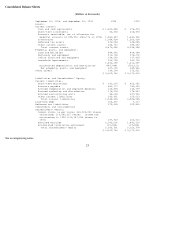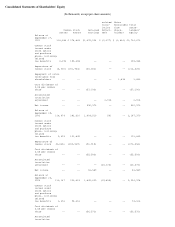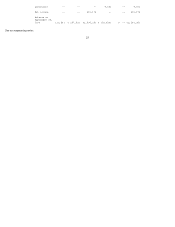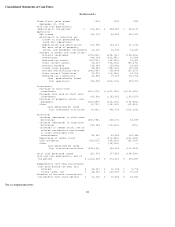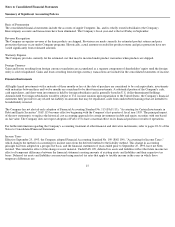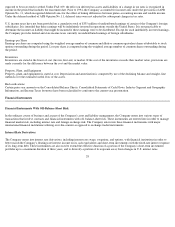Apple 1994 Annual Report Download - page 21
Download and view the complete annual report
Please find page 21 of the 1994 Apple annual report below. You can navigate through the pages in the report by either clicking on the pages listed below, or by using the keyword search tool below to find specific information within the annual report.The Company's financial position with respect to cash, cash equivalents, and short-term investments, net of short-
term borrowings, increased to
$966 million at September 30, 1994, from $69 million at September 24, 1993. This increase reflects a $300 million issuance of ten-year
unsecured notes, the proceeds of which replaced a portion of the Company's short-
term financing. The improvement in the Company's financial
condition was also attributable to the Company's continued efforts to increase profit levels and to manage working capital, particularly in the
area of inventory management.
More cash was generated by operations in 1994 compared with 1993, primarily because of a significant decrease in inventory levels, as well as
increased sales levels. The significant decrease in inventory levels during 1994 resulted from improved inventory management, higher 1994
sales levels attributable to various pricing and promotional actions, and strong sales of new product inventory which had been built up in
preparation for the introduction of Power Macintosh. Profit levels improved as operating expenses decreased due to the Company's
implementation of restructuring actions initiated in the third quarter of 1993.
Cash generated by operations in 1994 was partially offset by cash used for restructuring and an increase in accounts receivable. The increase in
accounts receivable reflected an increase in sales levels achieved during 1994. The balance of accrued restructuring costs decreased as the
restructuring actions initiated in the third quarter of 1993 continued to be implemented. In addition, in the third quarter of 1994, the Company
lowered its estimate of the costs associated with the restructuring and recorded an adjustment that increased income by $127 million ($79
million, or $0.66 per share, after taxes). This adjustment primarily reflected the modification or cancelation of certain elements of the
Company's original restructuring plan because of changing business and economic conditions that made certain elements of the restructuring
plan financially less attractive than originally anticipated.
More cash was used for operations in 1993 compared with 1992, primarily because of a significant increase in inventory levels; decreases in
net income, income taxes payable, and other current liabilities; and an increase in accounts receivable levels. Cash used for operations was
offset slightly by increases in accrued restructuring costs and accounts payable.
Inventory increased substantially during 1993 as a result of higher levels of purchased parts, work in process, and finished goods inventory in
support of an expanded product line and distribution channels and anticipated higher sales volumes. The decrease in net income resulted
primarily from a reduction in gross margins and the restructuring charge included in operating expenses for the third quarter. The reduction in
earnings also contributed to the decrease in income taxes payable. Other current liabilities decreased as the Company continued to manage
operating expense levels. The increase in accounts receivable corresponded to the higher sales levels achieved in 1993 compared with 1992,
coupled with slower collections resulting from economic pressures in the reseller industry, and the Company's expansion into consumer
channels, where payment terms are generally longer. These uses of cash were offset slightly by increases in accrued restructuring costs as a
result of the Company's plan to restructure its operations worldwide and increases in accounts payable, reflecting the higher level of inventory
purchases.
Excluding short-term investments, net cash used for investments declined in 1994 compared with 1993 and 1992 levels. Net cash used for the
purchase of property, plant, and equipment totaled $160 million in 1994,
19
Liquidity and Capital Resources 1994 1993 1992
Cash, cash equivalents, and short-term
investments, net of short-term borrowings $ 966 $ 69 $ 1,251
Working capital $ 2,532 $ 1,830 $ 2,151
Cash generated by (used for) operations $ 737 $ (651) $ 921
Cash used for investment activities, excluding
short-term investments $ 163 $ 228 $ 264
Cash generated by (used for) financing
activities $ (208) $ 336 $ (114)


